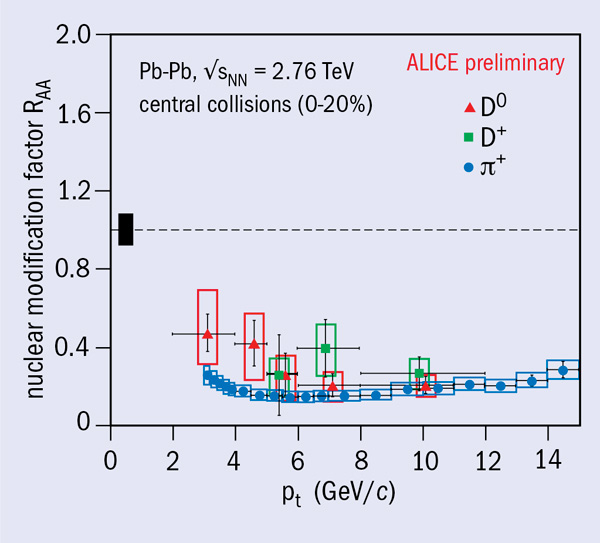
The ALICE collaboration has measured the production of the charmed mesons D0 and D+ in lead–lead collisions at the LHC. In central (head-on) collisions they find a large suppression with respect to expectations at large transverse momentum, pt, indicating that charm quarks undergo a strong energy loss in the hot and dense state of QCD matter formed at the LHC. This is the first time that D meson suppression has been measured directly in central nucleus–nucleus collisions.
Heavy-flavour particles are recognized as effective probes of the highly excited system (medium) formed in nucleus–nucleus collisions; they are expected to be sensitive to its energy density, through the mechanism of in-medium energy loss. The nuclear modification factor RAA – the ratio of the yield measured in nucleus–nucleus collisions to that expected from proton–proton collisions – is well established as a sensitive observable for the study of the interaction of hard partons with the medium. Because of the QCD nature of parton energy-loss, quarks are predicted to lose less energy than gluons (which have a higher colour charge); in addition, the so-called “dead-cone” effect and other mechanisms are expected to reduce the energy loss of heavy partons with respect to light ones. Therefore, there a pattern of gradually decreasing RAA suppression should emerge when going from the mostly gluon-originated light-flavour hadrons (e.g. pions) to the heavier D and B mesons: RAA(π) < RAA(D) < RAA(B). The measurement and comparison of these different probes provides, therefore, a unique test of the colour-charge and mass dependence of parton energy-loss.
Experiments at the Relativistic Heavy Ion Collider at Brookhaven measured the suppression of heavy flavour hadrons indirectly in gold–gold collisions at 200 GeV through the RAA of the inclusive decay electrons. Using data from the first lead–lead run at the LHC (√sNN = 2.76 TeV), the ALICE collaboration has measured the production of prompt D mesons via the reconstruction of the decay vertex in the channels D0→K–p+ and D+→K–p+p+. The results show a suppression of a factor 4–5, as large as for charged pions, above 5 GeV/c (see figure). At lower momenta, there is an indication of smaller suppression for D than for π mesons. Data with higher statistics, expected from the 2011 lead–lead run, will allow the collaboration to study this region with more precision and address this intriguing mass-dependence in QCD energy-loss.
The result implies a strong in-medium energy loss for heavy quarks, as also suggested by the suppression measured by the ALICE collaboration for electrons and muons from heavy flavour decays, and by the CMS collaboration for J/Ψ particles from B meson decays.
Further reading
A Dainese et al. (ALICE collaboration) 2011 Proceedings of Quark Matter 2011 arXiv:1106.4042 [nucl-ex].





